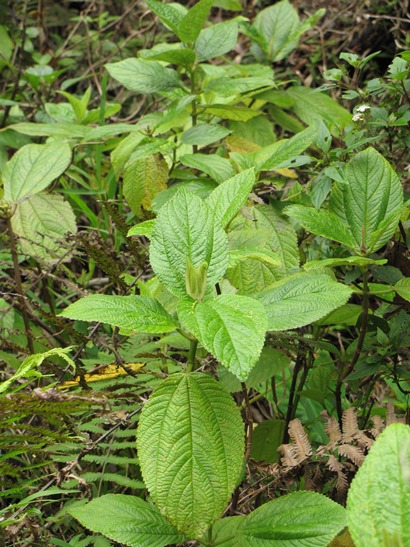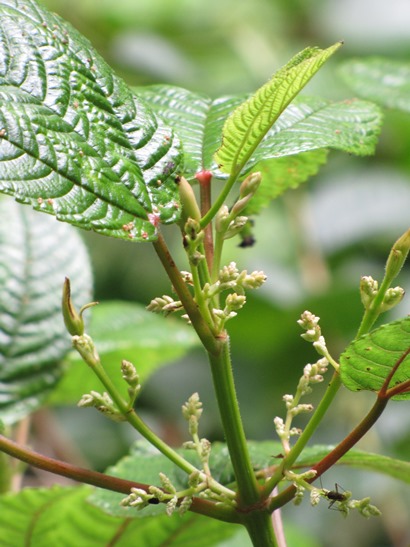The Kamehameha butterfly is highly specific to the plant family Urticaceae (nettle relatives), and its caterpillars are found only on the Hawaiian species in this family. This means that the butterfly can only reproduce in places where these plants occur. These plants are typically found in areas with native vegetation and moderate to heavy rainfall, often in shady areas or gulches. Most of them are shrubs or small trees, with broad, papery leaves and prominent veins.
The most commonly encountered host plant is:
māmaki (Pipturus albidus)

|

|
| A young māmaki plant. There is much variation in the amount of red coloration, with some individuals having much less red coloration in the stem and veins. Photo by Forest and Kim Starr. |
A māmaki leaf showing prominent red veins. Leaves are often used to make a medicinal tea. Photo by Forest and Kim Starr. |
| |
|

|

|
Māmaki fruits. Photo by Forest & Kim Starr.
|
Branches of a full grown māmaki tree. Photo by Will Haines. |
| |
|
| |
|
Other host plants are less common, but may be just as acceptable for caterpillars:
olonā (Touchardia latifolia)
ōpuhe (Urera spp.)

|
A young ōpuhe plant, Urera glabra. These plants have wide, glossy leaves, and are often found in shaded areas or gulches. Photo by Forest and Kim Starr.
|
| |
|
|

|
|

|
An ōpuhe plant, Urera glabra. Photo by Forest and Kim Starr.
|
|
A cluster of flowers and fruits of ōpuhe, Urera glabra. Photo by Forest and Kim Starr. |
ʻākōlea (Boehmeria grandis)
 |
|
 |
| The native ʻākōlea (Boehmeria grandis) is a small plant or shrub whose leaves look very similar to a young māmaki when it is not flowering or fruiting. Photo by Forest and Kim Starr. |
|
The flowers and fruits of ʻākōlea are very different from those of māmaki, being on stalks, rather than directly on the stem. Photo by Forest and Kim Starr. |
| |
|
|
 |
| Small ʻākōlea plants. The leaves of ʻākōlea come off the stem in pairs, opposite each other, unlike the leaves of māmaki which come off the stem in an alternate arrangement, with the leaves staggered along the stem. of Photo by Forest and Kim Starr |
 |
 |
| A young māmaki plant (Forest & Kim Starr) |
A māmaki leaf showing prominent
red veins (Forest & Kim Starr). Leaves are often used to make a medicinal tea. |
| |
|
 |

|
Māmaki fruits plant (Forest & Kim Starr)
|
A full grown māmaki tree (Leyla Kaufman)
|
 |
 |
| A young māmaki plant (Forest & Kim Starr) |
A māmaki leaf showing prominent
red veins (Forest & Kim Starr). Leaves are often used to make a medicinal tea. |
| |
|
 |

|
Māmaki fruits plant (Forest & Kim Starr)
|
A full grown māmaki tree (Leyla Kaufman)
|
 |
 |
| A young māmaki plant (Forest & Kim Starr) |
A māmaki leaf showing prominent
red veins (Forest & Kim Starr). Leaves are often used to make a medicinal tea. |
| |
|
 |

|
Māmaki fruits plant (Forest & Kim Starr)
|
A full grown māmaki tree (Leyla Kaufman)
|